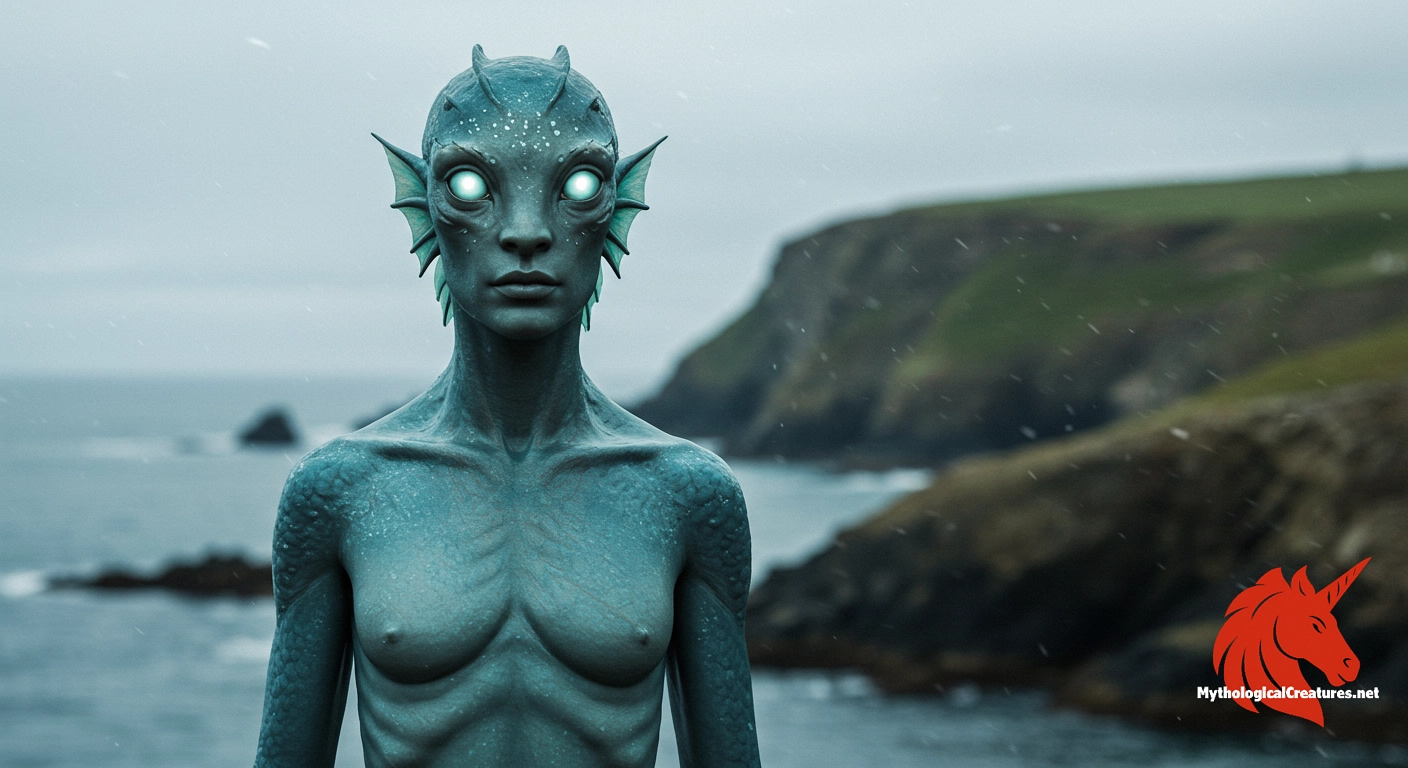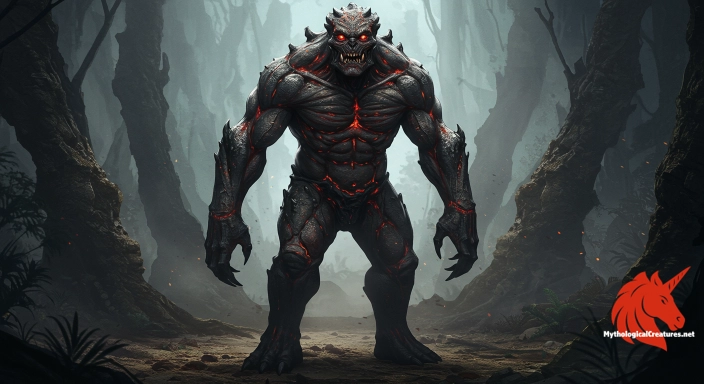Finfolk: The Finfolk are sorcerous, amphibious shapeshifters from Orkney folklore who journey from their secret underwater realm, Finfolkaheem, to the Orkney shores.

Finfolk
Finfolk - Their practice of abducting humans for forced servitude underscores the mysterious and perilous nature of the sea in local tradition.
Origins & First Encounters
The Finfolk are mystifying sea-dwellers emerging from the rich traditions of the Orkney Islands, whose very presence conjures both wonder and wariness. Born from the legends of a submerged realm known as Finfolkaheem, they traverse the boundary between land and sea with an air of ancient sorcery. Their stories, steeped in the mystery of the deep, carry echoes of a time when the ocean was seen as a living, capricious entity. Over the generations, these shapeshifters have come to symbolize the delicate balance between nature’s benevolence and its unpredictability. The dual roles of Finman and Finwife highlight the complex social dynamics and gendered mythologies woven into the fabric of coastal lore. Vibrant oral traditions recounted around flickering hearths and stormy nights have given them an almost timeless quality, inviting both admiration and caution. Their myth was shaped by communities whose lives depended on the sea, reflecting a deep respect for an environment both generous and forbidding. Engaging and elusive, the Finfolk continue to intrigue, standing as witnesses to the ancient interplay of human endeavour and natural forces. Their legend serves as a bridge between the tangible world of human experience and the mysterious, unseen depths of the ocean. Even as modernity casts new light on old narratives, the Finfolk remain emblematic of a natural world that is as unpredictable as it is enchanting.
Source Texts & Tale Variants
Ancient oral traditions offer the earliest glimpses into the enigmatic world of the Finfolk, with vibrant recountings shared through community gatherings and maritime lore. Written accounts, though rare in formal historical texts, have been preserved in local ballads, scrupulously maintained folktale manuscripts, and sea shanties that echo across the islands. These written recollections often articulate detailed encounters during the spring and summer, when the Finfolk make their enigmatic appearance on coastal shores. In some narrations, the emphasis falls on their subtle seduction while in others the focus is on their forceful abductions, leading to variations that capture a spectrum of human emotions. Over time, different local versions have emerged, each reflecting the unique cultural psyche of the specific coastal community that birthed it. Some storytellers present them as mystical guardians, while others portray them as malevolent beings intent on disrupting human order. The careful chronicling of these tales, sometimes by travelling collectors or dedicated folklorists, has ensured that the narrative richness of the Finfolk endures. Distinct episodes of charm, danger, and supernatural transformation interlace across various recordings, creating a mosaic of perspectives that defy a single definitive version. Each version contributes its own nuance to the overall mythos, underscoring the dynamic nature of oral tradition. In this way, the Finfolk myth continues to evolve, with every retelling enhancing its layers and depth.
Form & Powers
The Finfolk are renowned for their mutable appearances, which seamlessly combine human allure with distinctly aquatic attributes. Many depictions portray them with elongated, graceful limbs that conclude in webbed fingers and toes, signalling their inherent connection to the water. Their skin is often described as possessing a pearlescent quality, reflecting seafoam glints and the subtle colours of the deep ocean. Eyes that glow faintly with an inner luminescence are a recurring detail, hinting at the magical depths from which their power originates. They are sometimes shown with hints of scales along their skin or delicate, fin-like adornments along their limbs, emphasising their aquatic nature. In some accounts, the Finfolk’s hair flows with the hues of ocean tides, blending seamlessly with the foamy waves. Their physical form is not static, as legends recount how they can shift between a rugged, sea-weathered appearance and one of ethereal, otherworldly beauty. Variations in size also appear throughout the tales, with some narratives positioning them as taller-than-average figures exuding a statuesque elegance. This dynamic physicality underscores their ability to adapt to both terrestrial and marine environments, a trait central to their identity. Ultimately, every aspect of their form is imbued with symbolism, reflecting the unpredictable and ever-changing nature of the sea itself.
Regional Faces
Local interpretations of the Finfolk diverge in fascinating ways across the archipelago, with each region infusing the myth with its own distinctive flavour. In the heart of the Orkney Islands, their portrayal often emphasises the duality of charm and peril, representing both an enticing mystery and a formidable threat. Nearby coastal communities sometimes interpret these beings as guardians of the underwater realm, imbuing their myth with an element of sacred custodianship over hidden marine treasures. Folk tales from remote isles may stress their role in seasonal cycles, with appearances marking the transition from the safety of winter to the uncertainty of spring. Some local adaptations even recount rituals and social taboos that developed around ensuring a safe season free from their supernatural influence. In other parts of the northern isles, the Finfolk’s narrative is interlaced with elements of both seduction and retribution, reflecting regional attitudes towards the power of nature. Variations in nomenclature further underscore regional nuances, with some tales referring to them by names that echo local linguistic traditions. The diverse cultural landscape of the northern seas has allowed these legends to flourish in numerous forms, each tailored to the unique environment and social history of its people. Such regional variations not only enrich the overall myth but also reinforce the significance of natural landscapes in shaping folklore. Ultimately, these differences highlight how the enduring Finfolk myth adapts to the specific cultural and geographical context of each community it touches.
Cultural Parallels
Comparative insights reveal that the Finfolk share intriguing similarities with a wide array of aquatic beings found in other mythological traditions. Their shape-shifting capabilities and dual nature are reminiscent of the Celtic Selkies, who, like the Finfolk, navigate the liminal space between land and water with beguiling charm and an undercurrent of melancholy. Scandinavian legends offer parallel narratives with entities such as the Hafgufa, emphasising a deep-rooted cultural preoccupation with the mysteries of the sea. The recurring motif of abduction and forced companionship finds echoes in multiple European coastal myths, underscoring a shared caution against the unpredictable nature of maritime life. Just as the Finfolk blur the lines between beauty and danger, other mythic figures often embody the tension between human vulnerability and the overwhelming might of natural forces. These cross-cultural comparisons reveal how isolated communities, regardless of geographical separation, have grappled with the awe-inspiring and sometimes treacherous character of the ocean. The interplay between enchantment and menace present in these myths speaks to a universal human experience with the unpredictable realm of water. Each tradition, whether rooted in the folklore of the Orkney Islands or in distant maritime cultures, reflects common themes of transformation, seduction, and retribution. This shared narrative heritage strengthens the understanding of the Finfolk as part of a broader, interconnected tapestry of aquatic legends. Their mythological presence thus offers a window into how diverse cultures similarly venerate and fear the power of the sea.
Legacy & Modern Evolution
The depiction of the Finfolk has evolved remarkably over the centuries, mirroring shifts in cultural attitudes towards nature and the supernatural. Early portrayals cast them as fierce abductors wielding unyielding magic—a clear reflection of a time when the ocean was both a vital resource and a source of terror. Over time, the narrative has softened in certain retellings, with modern adaptations often highlighting their enigmatic qualities and the tragic elements of their existence. In contemporary literature and art, the Finfolk are frequently reimagined not solely as supernatural predators but as complex beings caught between worlds. This evolution has allowed them to serve as potent symbols of nature’s dual capacity to nurture and to punish. Modern storytellers and visual artists imbue the Finfolk myth with layers of ecological allegory, exploring themes of environmental change and the loss of ancient wisdom. Festivals, theatrical productions, and digital media projects in coastal regions have revived interest in their legend, transforming these beings into cultural icons of maritime heritage. Their narrative now resonates as much with the modern environmental conscience as with traditional folklore. The shifting portrayals underscore the adaptive quality of myth, capable of reflecting contemporary anxieties and hopes. In every retelling, the Finfolk continue to captivate audiences, serving as a timeless reminder of the enduring and mysterious allure of the sea.
Interesting Fact
An interesting observation is that despite their mesmerizing beauty and charm, the Finfolk's true nature remains shrouded in mystery, reflecting the ever-changing and elusive character of the ocean.
Quick Creature Info
Features:
Associations:
Our Mythic Legendary Rating:

Also Sometimes Known As:
Habitat:
Supernatural Powers:
Physical Attributes:
Abilities:
Behavior:
Lore:
References
Discover Another Mythical Legend You May Not Have Heard Of?
Uncover the mysteries of ancient folklore and expand your knowledge of legendary beings from cultures around the world.
Dare to Meet the Kroni....
Mythical Disclaimer: The images and data on this site are derived from various historical and literary sources, but we have found that many myths often have multiple versions and interpretations across references, sometimes contradictory. As a result, these creature depictions are artistic interpretations—imaginative blends of folklore, legend, and a dash of AI guesswork. Because creature descriptions vary widely, our illustrations and accompanying information represent our best effort to honor mythology while bridging creative gaps. Enjoy these interpretations—just remember, we've done our best to respect the stories and validate available data, but in the realm of mythology, details often shift, imagination leads the way, and nothing is ever set in stone!
Curated by the Mythological Creatures Team (rev. May 2025)
